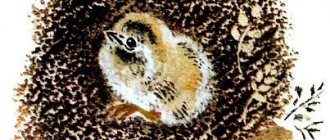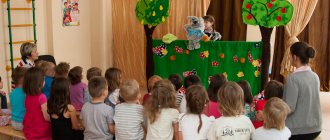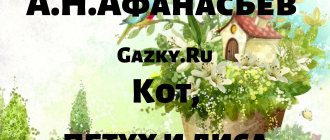Abstract of the OOD on fiction “Reading the fairy tale “The Fox and the Jug”
Yulia Kutova
Abstract of the OOD on fiction “Reading the fairy tale “The Fox and the Jug”
Educational field: Speech development
arouse interest in fiction .
Educational: teach to understand and retell the content of the fairy tale “ The Fox and the Jug ”
.
Developmental: develop children's voluntary visual attention and memory, verbal and logical thinking, speech and activate their vocabulary.
Educational: to develop in children the ability, without interrupting, to listen to the answers of their comrades, to take turns; to cultivate in children empathy and a desire to help someone who is in a difficult situation.
guess a riddle, answer the teacher’s questions, tell a fairy tale using a mnemonic table , and perform articulation exercises.
Materials and equipment:
toys of wild animals, mnemonic table for the fairy tale “ The Fox and the Jug ”
, illustrations depicting a sickle and sheaf
motivational and incentive stage, reading a fairy tale , conversation on the content of the fairy tale , questions, physical education, re -reading the fairy tale , art . word, reflection,
Summary of a lesson on speech development in the senior group “The Fox and the Jug”
Svetlana Agafonova
Summary of a lesson on speech development in the senior group “The Fox and the Jug”
Retelling of the fairy tale " The Fox and the Jug "
Goals: tell the fairy tale “ The Fox and the Jug ”
without the help of the teacher’s questions, expressively convey the conversation between the fox and
the jug ; explain the meaning of the word “reap”
;
select synonyms for verbs; learn to compose sentences, correctly combining words according to their meaning, practice “reading”
sentences after rearranging words;
encourage the use of different intonations in speech .
Visual material. Fairy tale " The Fox and the Jug "
.
Lesson objectives
Educational
- to develop in children the ability to listen carefully to an adult’s story, to follow the rules of a group game; develop learning skills (answer an adult’s questions, listen to the answers of other children, do not interrupt the speaker).
Educational
— improve gross motor skills; consolidate children's knowledge on the topic “Where did the bread come from”; consolidate the general concept of “animals”; introduce children to new words: “rye”, “ears”, “grain”, “sheaf”, “sickle”, “jug”, “reap”; introduce the prepositions “for”, “before” into the children’s active vocabulary; adverbs “in front”, “behind”, “left”, “right”.
Developmental
— train children’s auditory and visual attention, the ability to solve riddles, and the ability to comprehend the events of a fairy tale.
Equipment:
- figures of fairy tale characters - a woman, a fox (see insert, Fig. 5, 6);
subject pictures - jug, sickle, sheaf (see insert, Fig. 7-9);
scenery: field, river (see insert);
demonstration drawing “Where is the jug?” (Fig. 11, p. 36).
Summary of GCD in the senior group “Retelling the fairy tale “The Fox and the Jug”
Tatyana Chesnokova
Summary of the GCD in the senior group “Retelling the fairy tale “The Fox and the Jug”
Goal: organize communicative activities aimed at developing coherent monologue speech through familiarization with the fairy tale “ The Fox and the Jug ”
.
– Improve the ability to tell a fairy tale without leading questions, expressively, using a mnemonic table as a visual support.
– Organize a process to activate and enrich children’s vocabulary. – Organize a process for the ability to pronounce sentences with different shades of intonation (angry, pleading, affectionate)
.
– Create conditions for instilling accuracy when working with plasticine.
• Visual – showing slides, looking at illustrations for a fairy tale .
• Gaming – game “Guess the Fairy Tale ”
, surprise moment, help
to a fairy-tale hero .
• Practical – plasticineography “ Jug ”
.
"Reap"
- this means cutting off the ears of wheat and rye at the root, harvesting the crop from the field.
Reading RNS, learning physical education lessons, talking about read fairy tales “Living Words” games
,
“Say a word”
,
“Guess the hero”
,
“Name it correctly”
, etc.
Material and equipment:
A book of fairy tales , a chest, an envelope with a note, illustrations for fairy tales , a Power Point presentation, a projector, a mnemonic table, a doll, blank jugs for each child , plasticine, an easel.
Fox and jug
A woman went out into the field to reap and hid a jug of milk behind the sheaves. The fox approached the jug, stuck its head into it, and lapped up the milk; It’s time to go home, but the problem is that he can’t get his head out of the jug.
The fox walks around, shakes his head and says: “Well, jug, I was joking, and it will be - let me go, little jug! You’ve had enough of spoiling, my dear, I’ve played and that’s enough.”
The jug doesn't lag behind, no matter what you want. The fox got angry: “Wait, you damned one, if you don’t lag behind in honor, then I’ll drown you.”
The fox ran to the river and let's drown the jug. The jug drowned, and he pulled the fox with him.
LESSON 1
Topic of the lesson: listening to the fairy tale “The Fox and the Jug.”
Preliminary work: children, under the guidance of an adult, cut out decorations and figurines of fairy tale characters from colored stickers and place them on stands.
An adult talks with children on the topic “Where did the bread come from?” He tells that wheat and rye are first sown in the field, ears of grain grow from them, in which the grain ripens by autumn. This grain is collected and ground into flour. And bread is baked from flour. Various machines help people in this work: seeders, tractors, combines. Grain is ground in mills, and bread is baked in large ovens in bakeries.
The adult reminds the children that the hare, fox, wolf, squirrel, and bear are wild animals (they live in the forest).
Lesson objectives
Educational
- to develop in children the ability to listen carefully to an adult’s story, to follow the rules of a group game; develop learning skills (answer an adult’s questions, listen to the answers of other children, do not interrupt the speaker).
Educational
— improve gross motor skills; consolidate children's knowledge on the topic “Where did the bread come from”; consolidate the general concept of “animals”; introduce children to new words: “rye”, “ears”, “grain”, “sheaf”, “sickle”, “jug”, “reap”; introduce the prepositions “for”, “before” into the children’s active vocabulary; adverbs “in front”, “behind”, “left”, “right”.
Developmental
— train children’s auditory and visual attention, the ability to solve riddles, and the ability to comprehend the events of a fairy tale.
Equipment:
- figures of fairy tale characters - a woman, a fox (see insert, Fig. 5, 6);
- object pictures - jug, sickle, sheaf (see insert, Fig. 7-9);
— scenery: field, river (see insert);
— demonstration drawing “Where is the jug?” (Fig. 11, p. 36).
Progress of the lesson
1. Organizational moment. Tell the children: “Let’s stand on the meadow and make a circle.” (Children and the teacher stand in a circle.) Ask the children what wild animals of our forests they know. Children take turns naming the animals and sitting on chairs arranged in a semicircle near the table.
2. Introduction to the fairy tale. Tell the children that today they will hear an old Russian folk tale about one of the animals of the Russian forest. And about which one, they will have to guess. Read the riddle to the children:
Behind the trees and bushes It flashed like a flame, Flashed, ran through - There was no smoke, no fire.
(Fox)
When the children name the animal, tell the kids the name of the fairy tale they are about to hear: “The Fox and the Jug.” Read or tell the children the fairy tale “The Fox and the Jug” while displaying the scenery and characters.
3. Think and answer. Ask the children questions about the content of the fairy tale. Who came to the field? (Woman.)
What was the woman doing in the field? (The rye stung. This means she cut the ears of grain with a sickle. The sickle is a large rounded knife, especially for such work. The woman tied the cut ears into sheaves and placed them on the field. In those distant times when this fairy tale was invented, there was no tractors, no combines, and people in the field had to do everything with their own hands.)
What did the woman bring to the field besides the sickle? (Jug.)
What was in the jug? (Milk.)
Why did the woman take milk from the field? (So that later, when he sits down to rest, he can drink milk.)
Where did the woman put the jug? (For the sheaves.)
Who found the jug? (Fox.)
What did the fox do? (Lapped milk.)
How did the fox get the milk from the jug? (She stuck her head into the jug.)
What then happened to the fox? (Head stuck in jug.)
What did the fox say to the jug? (“Let me go. I was joking and it will be.”)
Did the jug answer her? Did the jug let the fox go? (No.)
Who is to blame for the fox getting his head stuck: the jug or the fox itself? (Fox.)
What did the fox do? (She began to heat the jug.)
Did the jug drown? (Yes.)
And the fox? (Yes.)
Did the fox manage to outsmart the jug? (No.)
4. Fairytale riddles. Place pictures of a sickle, an ear of corn and a sheaf on the table in front of the children. Make riddles. Invite the children to listen carefully and show the answers.
The good moon shone in the field during the day, and soared into the sky by night. (Sickle)
There is a house on a straw, There are a hundred grains in it. (Ear of bread)
In the middle of the field he will stand in a straw caftan. Belted not with a belt, but with an ear of grain.
(Sheaf)
5. Outdoor game “Sheaf and ear of corn”. Invite the children to go out onto the meadow and make a circle on their own. Tell them that now they will depict a field with ears of grain.
To do this, you need to stand on tiptoes and raise your arms up. Then invite the children to show them a sheaf—many ears of grain gathered together. To do this, kids need to hold hands, approach the center of the circle, as close to each other as possible, and raise their clasped hands up.
When the movements have been learned, explain to the children the rules of the outdoor game: at the command “ears of corn,” the kids should disperse from the center of the circle, holding hands and moving backwards until they stand in a large circle. Then each child needs to stand on tiptoes, stretch their arms up and pretend to be a spikelet. At the command “sheaf”, children, holding hands, must again converge to the center of the circle and depict a large sheaf of ears of grain.
Change the commands “sheaf” and “ear” several times.
6. Where is the jug? Show the children the picture “Where is the jug?” (Fig. 11, p.3b) and discuss where the woman put the jug. Answer options: “before the sheaf”, “behind the sheaf”.
Clarify what is in front and what is behind (sheaf or jug). Find pictures where the jug is to the left of the sheaf, and where it is to the right.
Then give individual tasks to the children: use the “sheaf” decoration and the “jug” attribute to show all these options for the location of one object relative to another.
7. Summing up the lesson. Give positive feedback to the children's work.
LESSON 2
Topic of the lesson: telling the fairy tale “The Fox and the Jug.”
Lesson objectives
Educational
- to develop in children the ability, without interrupting, to listen to the answers of their comrades, to take turns; to cultivate in children empathy and a desire to help someone who is in a difficult situation.
Educational
— improve fine motor skills, the ability to regulate the force of impact; expand children's vocabulary through antonym words: good - evil, smart - stupid, cunning - simple-minded, honest - dishonest (deceiver); introduce the general word “dishes” into children’s speech; give children an idea of the parts that make up the dishes: bottom, lid, spout, neck, handle; improve children's coherent speech skills.
Developmental
- develop auditory and visual attention (the ability to differentiate noise, select the missing part of an object by shape); teach children to think and find a way out of a difficult situation.
Equipment:
- figures of fairy tale characters - a woman, a fox (see insert, Fig. 5, 6);
- object pictures - jug, sickle, sheaf (see insert, Fig. 7-9);
— scenery: field, river (see insert);
— dishes (cup, bottle and teapot);
- pencil;
- table screen;
— demonstration drawing “The fox broke the jug” (Fig. 12, p. 37);
- sheets with individual graphic tasks (Fig. 13, p. 37) according to the number of children.
Progress of the lesson
1—1
1. Organizational moment. Tell the children: “We stood on the meadow and made a circle.” (Children and the teacher stand in a circle.) Invite the children to remember which Russian folk tales with the participation of a fox they know. (“Kolobok”, “Teremok”, “Cat, Rooster and Fox”, “Zayushkina’s Hut”, “Fox with a Rolling Pin”, “Fox and Jug”.)
2. Let's think together. Ask the children what kind of fox is in fairy tales - honest or dishonest (a liar), good or evil, smart or stupid, cunning or simple-minded. Together with your children, conclude that the fox in fairy tales is most often cunning and deceives everyone.
After this, ask the children: “And in the fairy tale “The Fox and the Jug,” what kind of fox turned out to be? (Angry and stupid. The fox managed to deceive the woman, but could not outwit the jug. The fox got angry at the jug - she wanted to drown it, and along with it she destroyed herself.)
3. Joint retelling. Invite the children to conduct a collective retelling of the fairy tale “The Fox and the Jug.” When retelling, each child speaks 1-2 sentences. Use a gesture to let the children know whose turn it is to continue the retelling. Sequentially display the scenery and character figures yourself, and perform the actions described in the fairy tale with them. If any of the children have difficulties, then ask him a leading question or start the next phrase yourself.
4. We will help everyone. Tell the children that the fox should not have been angry at the jug, but should have thought better about how to get rid of it. Invite the kids to think about this topic themselves. If the children cannot find a way out of a difficult situation, show them a picture of how a fox broke a jug (Fig. 12, p. 37) and ask them to express their opinion.
Say that if the fox had not been angry, but instead thought carefully, he would have been able to free himself from the jug. But the woman will still be upset. She comes to rest after work and sees that the jug is broken and there is no milk. We need to help the woman - collect and glue her jug. Invite the children to look carefully at the picture (Fig. 13, p. 37) and choose from the fragments the one that fits the shape of the broken jug.
5. Find out by sound. Praise the children for repairing the jugs and tell them that you don’t have a real jug, but you do have other utensils. Place a bottle, cup and teapot on the table in front of the kids. Tap them with a pencil and ask the children to remember what sound each of these objects makes. Then place a screen on the table, hiding the dishes behind it, and invite one of the children to ask a sound riddle to their friends.
Warn that, unlike the fox, we cannot hit the dishes, we must handle them carefully, so don’t hit them too hard with a pencil. The called child comes to the table, takes a pencil and knocks on one of the utensils. The rest of the children guess by sound what it sounded. Invite all the children in turn to make a sound riddle to their friends.
6. Name the parts. Remove the screen from the table and invite the children to carefully examine the dishes. Show and name its parts to the kids - bottom, neck, handle, spout and lid.
Invite the children to name and show all these parts again and repeat the names of the objects: bottle, cup, teapot.



